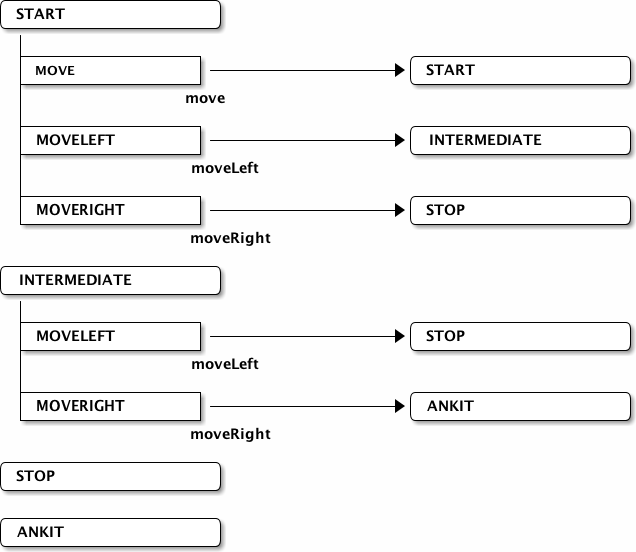This library facilitates creation of a Finite State Machine (FSM). Library generates a Finite State Machine (FSM) from a configuration file specified while invoking the object for the FSM class.
Current library has been built as Java Library Project in Netbeans 7.0.1
## To buildSource code (EasyFSM.zip) can be extracted and built in a Netbeans IDE or can even be ported to an Eclipse environment.
## To Use LibraryAdd EasyFSM.jar to the Java Library folder of your project or Java Installation. Ensure that the CLASSPATH variable of your build environment has the EasyFSM.jar in its path.
## UsageJust a test example for usage (Example1.java):
/**
* Example1 Code exemplifies the usage of FSM with a fixed path XML configuration file
**/
import Action.FSMAction;
import FSM.FSM;
public class Example1 {
public static void testFSM() {
try {
FSM f = new FSM("C:https://config.xml", new FSMAction() {
@Override
public boolean action(String curState, String message, String nextState, Object args) {
javax.swing.JOptionPane.showMessageDialog(null, curState + ":" + message + " : " + nextState);
/*
* Here we can implement our login of how we wish to handle
* an action
*/
return true;
}
});
System.out.println(f.getCurrentState());
f.ProcessFSM("MOVELEFT");
System.out.println(f.getCurrentState());
f.ProcessFSM("MOVE");
System.out.println(f.getCurrentState());
f.ProcessFSM("MOVERIGHT");
System.out.println(f.getCurrentState());
} catch (ParserConfigurationException ex) {
Logger.getLogger(TestOwnCode.class.getName()).log(Level.SEVERE, null, ex);
} catch (SAXException ex) {
Logger.getLogger(TestOwnCode.class.getName()).log(Level.SEVERE, null, ex);
} catch (IOException ex) {
Logger.getLogger(TestOwnCode.class.getName()).log(Level.SEVERE, null, ex);
}
}
public static void main(String[] args) {
try {
testFSM();
} catch (Exception ex) {
Logger.getLogger(TestOwnCode.class.getName()).log(Level.SEVERE, null, ex);
}
}
}
Another example (Example2.java):
/**
* Example2 Code exemplifies the usage of FSM with a XML configuration file specified
* within the project as resource.
**/
import Action.FSMAction;
import FSM.FSM;
public class Example2 {
private String _configFileName = "resource/config.xml";
public static void testFSM() {
try {
FSM f = new FSM(this.getClass().getClassLoader().getResourceAsStream(_configFileName), new FSMAction() {
@Override
public boolean action(String curState, String message, String nextState, Object args) {
javax.swing.JOptionPane.showMessageDialog(null, curState + ":" + message + " : " + nextState);
/*
* Here we can implement our login of how we wish to handle
* an action
*/
return true;
}
});
System.out.println(f.getCurrentState());
f.ProcessFSM("MOVELEFT");
System.out.println(f.getCurrentState());
f.ProcessFSM("MOVE");
System.out.println(f.getCurrentState());
f.ProcessFSM("MOVERIGHT");
System.out.println(f.getCurrentState());
} catch (ParserConfigurationException ex) {
Logger.getLogger(TestOwnCode.class.getName()).log(Level.SEVERE, null, ex);
} catch (SAXException ex) {
Logger.getLogger(TestOwnCode.class.getName()).log(Level.SEVERE, null, ex);
} catch (IOException ex) {
Logger.getLogger(TestOwnCode.class.getName()).log(Level.SEVERE, null, ex);
}
}
public static void main(String[] args) {
try {
testFSM();
} catch (Exception ex) {
Logger.getLogger(TestOwnCode.class.getName()).log(Level.SEVERE, null, ex);
}
}
}
XML Configuration file should be of the following format:
<?xml version="1.0" encoding="UTF-8"?>
<!--
Document : config.xml
Created on : 22 March, 2013, 9:05 AM
Author : ANKIT
Description:
File specifies states and transition of an FSM.
This is an example file.
-->
<FSM>
<STATE id="START" type="ID">
<MESSAGE id="MOVE" action="move" nextState="START" />
<MESSAGE id="MOVELEFT" action="moveLeft" nextState="INTERMEDIATE" />
<MESSAGE id="MOVERIGHT" action="moveRight" nextState="STOP" />
</STATE>
<STATE id="INTERMEDIATE">
<MESSAGE id="MOVELEFT" action="moveLeft" nextState="STOP" />
<MESSAGE id="MOVERIGHT" action="moveRight" nextState="ANKIT" />
</STATE>
<STATE id="STOP" />
<STATE id="ANKIT" />
</FSM>
And here is a diagram representing the transitions for this finite state machine:
